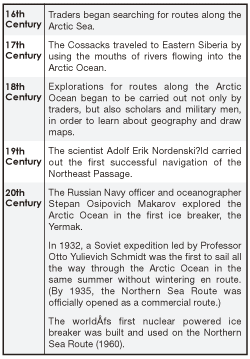2009.02.20
Arctic Sea Ice and the Northeast Passage
Science Café: Chiba University and Weathernews
On January 16, 2009 (Friday), Chiba University and Weathernews Inc. (WNI) held a Science Café seminar. At this Science Café, we had distinguished guests from the United States and Russia, both of them top-notch researchers in the field of sea ice. Discussions were held on the status of sea ice coverage in the Arctic Circle, and the development of the Northeast Passage. In addition, an introduction to the activities and services of the WNI Global Ice Center was also given.
Significant Decrease in Arctic Sea Ice (Dr. Comiso)
Atmospheric temperatures continue to rise dramatically since 1990. This trend is also seen clearly at the poles of the earth. This rise in temperature would then lead to more sea ice melting, creating another decrease in the sea ice amount.
The sea ice in the Artic Ocean is decreasing year by year. The decrease since 2007 is especially dramatic, and showed the smallest area of sea ice since satellite observations began. In 2008, sea ice along the Northwest and Northeast Passages decreased, and both routes became navigable. According to one simulation, the sea ice in the Arctic Circle may completely disappear in this century.
In recent years, signs of global warming have been found not only in the Arctic, but also the Antarctic. The fact that the so-called permanent ice is decreasing can be taken as a warning that we may see an iceless Arctic in the near future.
We need not only detailed studies on global warming, but also global interest and international cooperation, as well, in order to tackle this issue.

Year-round Voyages on the Northern Sea Route Possible by 2015 (Dr. Mitnik)
The history of trying to traverse the Northeast Passage in Russia is long, and was undertaken both as a military effort as well as for economic merit. (See timeline right).
In the 21st century, the Northeast Passage is gaining new attention as a possible route through which to transport oil and gas. Ships traversing the polar region use four different routes: Coastal, Marine, High Latitude and Polar. No matter which one is used, it is important to make sure the vessel is using a route that is in a safe and easy ice condition.
Russia has plans to build a modern, nuclear powered ice-breaker. This ice-breaker is expected to allow year-round voyages through the Arctic Sea possible.
Supporter-based Sea Ice Eyservations (Daisuke Abe)
Weathernews Inc. opened Global Ice Center in the summer of 2008, in order to work closely with maritime companies, universities and other research facilities to help realize Polar Routeing.
Currently, our Global Ice Center provides ice information for the Baltic Sea, the White Sea, the Sea of Okhotsk and the Gulf of St. Lawrence to a shipping company that operates tankers. In addition, we have also recently launched our website, in which the latest sea ice data is updated regularly. (URL: http://weathernews.com/GIC/)
In order to provide total service, from voyage planning, go or no go decision support and en route operational safety support, a through understanding of the sea ice situation in high altitudes and near the poles, as well as forecasts of the ice, is a necessity. We also have plans to begin providing historical data, such as past dates of freezing and melting, as well as past greatest area of ice coverage, etc.
In addition, we also have plans to create even more enriched contents, based on reports from people living near the coasts as well as ships navigating the areas. These contents are envisaged to include hard to predict elements such as the actual shape and thickness of the ice, as well as ice near the coastlines.

- Dr. Josefino C. Comiso
- NASA Goddard Space Flight Center (USA)

- Dr. Leonid Mitnik
- Russian Academy of Sciences, Far Eastern Branch (Russia)

- Daisuke Abe
- Groupe leader of Global Ice Center, Weathernews Inc.

